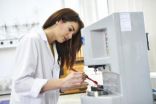(Press-News.org) In a new study led by UC San Francisco (UCSF) scientists, a chemical compound designed to precisely target part of a crucial cellular quality-control network provided significant protection, in rats and mice, against degenerative forms of blindness and diabetes.
In addition to opening a promising drug-development path for the wide range of diseases caused by cell loss, the new research offers a new view of the workings of the unfolded protein response (UPR), a cellular "life-or-death" signaling network: When cells are under stress, the UPR works to ensure that they produce properly configured proteins, but those cells not up to this task are quickly prompted by the UPR to self-destruct.
A component of the UPR known as the IRE1 pathway has generally been thought to handle the protective aspects of this response, promoting cell survival by providing cells with the biological resources they need to cope with stress, while a complementary pathway, called PERK, has been associated with cell death.
But in the new research, published in the July 10, 2014 edition of Cell, when researchers used KIRA6, a small-molecule kinase inhibitor they designed to inhibit the actions of IRE1 alpha —the molecular sensor that triggers the IRE1 pathway—they blocked cell death and preserved function in experimental models of two human diseases.
In two rat models of retinitis pigmentosa, a disease in which light-sensing cells in the eye progressively die off, causing blindness, KIRA6 preserved both the number of these cells and visual function. And in mice from a strain known as Akita, which carry a genetic mutation that causes diabetes in early life as stressed insulin-producing beta cells of the pancreas degenerate, KIRA6 protected beta cells from cell death, leading to a two-fold increase in insulin production and improving blood glucose control.
"This is a huge advance in our field," said co-senior author Scott A. Oakes, MD, associate professor of pathology at UCSF. "On the surface these would seem to be two very different diseases, but IRE1-induced cell death is at the root of both of them."
The results are the culmination of "a gigantic project," first to establish that the IRE1 pathway could drive degenerative disease, and then to design and test compounds to head off the damage, said UCSF's Feroz Papa, MD, PhD, associate professor of medicine and co-senior author, and a member of the California Institute for Quantitative Biosciences. "It took four years, over a hundred separate experiments in various contexts—not counting replications—and involved 24 researchers working in seven labs labs across four cities."
KIRA6 is the latest in a series of compounds (the acronym stands for "Kinase-Inhibiting RNase Attenuators) that were originally designed and synthesized in the labs of study co-authors Dustin J. Maly, PhD, associate professor of chemistry at The University of Washington, Seattle, and Bradley J. Backes, PhD, associate professor of medicine at UCSF.
"While KIRA6 showed efficacy in animals," said Papa, "it is important to stress that more optimization through medicinal chemistry efforts is needed to develop this class of compounds to the stage where they could be tested for efficacy in humans through clinical trials."
Oakes and Papa said that support from the Cleveland, Ohio-based Harrington Discovery Institute was crucial to sustaining this complex collaboration. Both scientists were 2013 winners of Scholar-Innovator Awards from the Institute, which is part of The Harrington Project for Development and Discovery a $250 million national model to accelerate the development of medical breakthroughs by physician-scientists into medicines that benefit patients. Other critical support for the work came from the National Institutes of Health, the Juvenile Diabetes Research Foundation, the Burroughs Wellcome Fund, the American Cancer Society, and the Howard Hughes Medical Institute.
INFORMATION:
Other UCSF researchers on the project included Douglas B. Gould, PhD, associate professor of ophthalmology; Michael German, MD, professor of medicine; postdoctoral fellows Rajarshi Ghosh, PhD and Likun Wang, PhD, and graduate student Eric S. Wang, all co-first authors; postdoctoral fellows Aeid Igbaria, PhD, Shuhei Morita, MD, PhD, Kris Prado, MD, Maike Thamsen, PhD, Hector Macias, PhD, and Marcel V. Alavi, PhD; former research associate Deborah Caswell; graduate student Kurt F. Weiberth; and research associate Micah J. Gliedt. The team was also joined by other colleagues from The University of Washington, Seattle; The Miller School of Medicine at The University of Miami, Florida; and the Albert Einstein College of Medicine, in Bronx, New York.
UCSF is the nation's leading university exclusively focused on health. Now celebrating the 150th anniversary of its founding as a medical college, UCSF is dedicated to transforming health worldwide through advanced biomedical research, graduate-level education in the life sciences and health professions, and excellence in patient care. It includes top-ranked graduate schools of dentistry, medicine, nursing and pharmacy; a graduate division with world-renowned programs in the biological sciences, a preeminent biomedical research enterprise and two top-tier hospitals, UCSF Medical Center and UCSF Benioff Children's Hospital San Francisco. Please visit http://www.ucsf.edu.
New compound treats both blindness and diabetes in animal studies
Study offers fresh insights into the role of cellular stress in degenerative illnesses
2014-07-10
ELSE PRESS RELEASES FROM THIS DATE:
Chimpanzee intelligence determined by genes
2014-07-10
ATLANTA–A chimpanzee's intelligence is largely determined by its genes, while environmental factors may be less important than scientists previously thought, according to a Georgia State University research study.
The study found that some, but not all, cognitive, or mental, abilities, in chimpanzees depend significantly on the genes they inherit. The findings are reported in the latest issue of Current Biology.
"Intelligence runs in families," said Dr. William Hopkins, professor in the Center for Behavioral Neuroscience at Georgia State and research scientist in the ...
Climate change may bring more kidney stones
2014-07-10
As daily temperatures increase, so does the number of patients seeking treatment for kidney stones. In a study that may both reflect and foretell a warming planet's impact on human health, a research team found a link between hot days and kidney stones in 60,000 patients in several U.S. cities with varying climates.
"We found that as daily temperatures rise, there is a rapid increase in the probability of patients presenting over the next 20 days with kidney stones," said study leader Gregory E. Tasian, M.D., M.Sc., M.S.C.E., a pediatric urologist and epidemiologist at ...
In the gut, immunity is a 2-way street
2014-07-10
In recent years, it has become increasingly clear that many diseases are triggered or maintained by changes in bacterial communities in the gut. However, the general view up into now has been rather simple: bacteria stimulate the immune system, leading to inflammation or autoimmune disorders in a single direction.
Now, in work published in Immunity, scientists led by Sidonia Fagarasan from the RIKEN Center for Integrative Medical Science in Japan have painted a more complex picture: the gut immune system does not simply prevent the influx of pathogens, but is actively ...
Sleep disturbances, common in Parkinson's disease, can be early indicator of disease onset
2014-07-10
Amsterdam, NL, 10 July 2014 – Up to 70% of Parkinson's disease (PD) patients experience sleep problems that negatively impact their quality of life. Some patients have disturbed sleep/wake patterns such as difficulty falling asleep or staying asleep, while other patients may be subject to sudden and involuntary daytime sleep "attacks." In the extreme, PD patients may exhibit REM-sleep behavior disorder (RBD), characterized by vivid, violent dreams or dream re-enactment, even before motor symptoms appear. A review in the Journal of Parkinson's Disease discusses the underlying ...
Rice's silicon oxide memories catch manufacturers' eye
2014-07-10
Rice University's breakthrough silicon oxide technology for high-density, next-generation computer memory is one step closer to mass production, thanks to a refinement that will allow manufacturers to fabricate devices at room temperature with conventional production methods.
First discovered five years ago, Rice's silicon oxide memories are a type of two-terminal, "resistive random-access memory" (RRAM) technology. In a new paper available online in the American Chemical Society journal Nano Letters, a Rice team led by chemist James Tour compared its RRAM technology ...
Mayo Clinic calls for standardization of safe imaging protocols for children
2014-07-10
ROCHESTER, Minn. — The benefits of medical imaging far outweigh the risks when children receive The Right Exam, ordered The Right Way, with The Right Radiation Dose. However, overuse and misuse of imaging change the benefit-risk ratio and Mayo Clinic is leading a collaborative effort to ensure a national protocol is put into action. The commentary, published online in the Journal of Patient Safety, calls for the American College of Radiology, the Joint Commission, the Intersociety Accreditation Commission, and the Centers for Medicare & Medicaid Services to require three ...
NOAA's GOES-West satellite sees smoke from Canadian fires over US
2014-07-10
NOAA's Geostationary Operational Environmental Satellite or GOES-West satellite spotted smoke over the U.S. Mid-West from dozens of fires raging in Canada's Northwestern Territories.
At 1200 UTC (8 a.m. EDT) on July 9, 2014, GOES-West captured this image of the brownish-colored haze created by forest fires in Canada's Northwest Territories that drifted all the way into South Dakota. This image was created by the NASA GOES Project at NASA Goddard Space Flight Center, Greenbelt, Md.
According to Canada's Natural Resources, Canadian Wildland Fire Information System, fire ...
NASA sees Tropical Storm Neoguri losing punch along southern Japan's coast
2014-07-10
Once a powerful super typhoon, now an weakening tropical storm, NASA's Terra satellite saw a much weaker Tropical Storm Neoguri moving along the southern coast of Japan.
On July 10 at 0:35 UTC, the Moderate Resolution Imaging Spectroradometer (MODIS) instrument aboard NASA's Terra satellite captured an image of a more disorganized Tropical Storm Neoguri over east central Japan. At the time of the image, a more elongated Tropical Storm Neoguri's center was east of Kyushu, Japan.
A visible image from the Visible Infrared Imaging Radiometer Suite (VIIRS) instrument aboard ...
Sun-like stars reveal their ages
2014-07-10
Defining what makes a star "Sun-like" is as difficult as defining what makes a planet "Earth-like." A solar twin should have a temperature, mass, and spectral type similar to our Sun. We also would expect it to be about 4.5 billion years old. However, it is notoriously difficult to measure a star's age so astronomers usually ignore age when deciding if a star counts as "Sun-like."
A new technique for measuring the age of a star using its spin - gyrochronology - is coming into its own. Today astronomers are presenting the gyrochronological ages of 22 Sun-like stars. Before ...
World interest in research work on the benefits of the Okra plant
2014-07-10
Estonian-born Katerina Alba's research at the University of Huddersfield could help to improve the quality of some of the most popular emulsion-based food products – such as butter, mayonnaise, yoghurt and fruit drinks – and she is starting to gain an international profile for her work.
Katerina gained her MSc degree in nutrition and food science at the University and now she has embarked on research for a PhD. Working with her supervisor, Dr Vassilis Kontogiorgos, she is investigating the potential of carbohydrates extracted from the pods of the okra plant. They can ...
LAST 30 PRESS RELEASES:
Tracing the quick synthesis of an industrially important catalyst
New software sheds light on cancer’s hidden genetic networks
UT Health San Antonio awarded $3 million in CPRIT grants to bolster cancer research and prevention efforts in South Texas
Third symposium spotlights global challenge of new contaminants in China’s fight against pollution
From straw to soil harmony: International team reveals how biochar supercharges carbon-smart farming
Myeloma: How AI is redrawing the map of cancer care
Manhattan E. Charurat, Ph.D., MHS invested as the Homer and Martha Gudelsky Distinguished Professor in Medicine at the University of Maryland School of Medicine
Insilico Medicine’s Pharma.AI Q4 Winter Launch Recap: Revolutionizing drug discovery with cutting-edge AI innovations, accelerating the path to pharmaceutical superintelligence
Nanoplastics have diet-dependent impacts on digestive system health
Brain neuron death occurs throughout life and increases with age, a natural human protein drug may halt neuron death in Alzheimer’s disease
SPIE and CLP announce the recipients of the 2025 Advanced Photonics Young Innovator Award
Lessons from the Caldor Fire’s Christmas Valley ‘Miracle’
Ant societies rose by trading individual protection for collective power
Research reveals how ancient viral DNA shapes early embryonic development
A molecular gatekeeper that controls protein synthesis
New ‘cloaking device’ concept to shield sensitive tech from magnetic fields
Researchers show impact of mountain building and climate change on alpine biodiversity
Study models the transition from Neanderthals to modern humans in Europe
University of Phoenix College of Doctoral Studies releases white paper on AI-driven skilling to reduce burnout and restore worker autonomy
AIs fail at the game of visual “telephone”
The levers for a sustainable food system
Potential changes in US homelessness by ending federal support for housing first programs
Vulnerability of large language models to prompt injection when providing medical advice
Researchers develop new system for high-energy-density, long-life, multi-electron transfer bromine-based flow batteries
Ending federal support for housing first programs could increase U.S. homelessness by 5% in one year, new JAMA study finds
New research uncovers molecular ‘safety switch’ shielding cancers from immune attack
Bacteria resisting viral infection can still sink carbon to ocean floor
Younger biological age may increase depression risk in older women during COVID-19
Bharat Innovates 2026 National Basecamp Showcases India’s Most Promising Deep-Tech Ventures
Here’s what determines whether your income level rises or falls
[Press-News.org] New compound treats both blindness and diabetes in animal studiesStudy offers fresh insights into the role of cellular stress in degenerative illnesses



